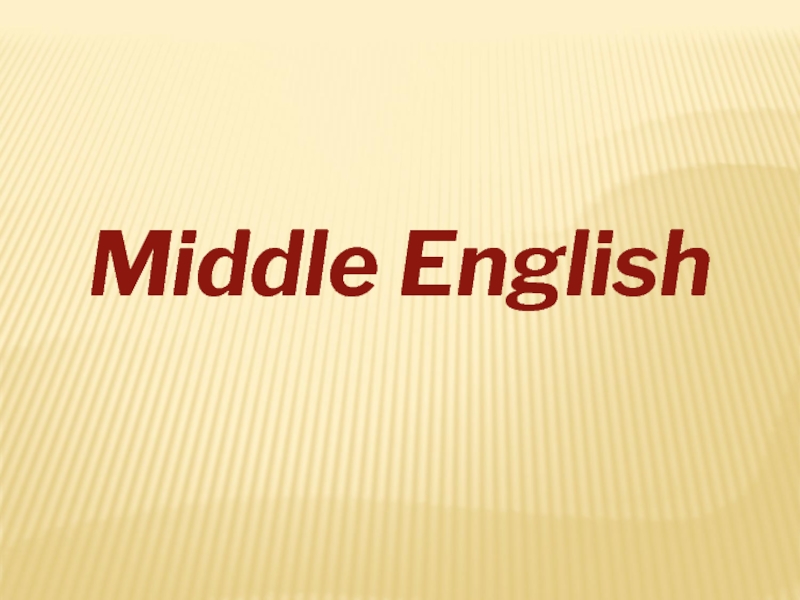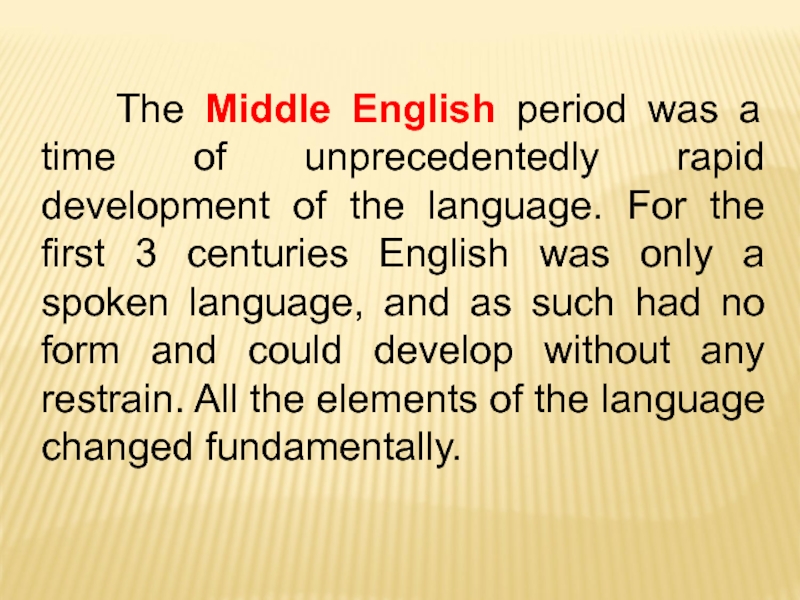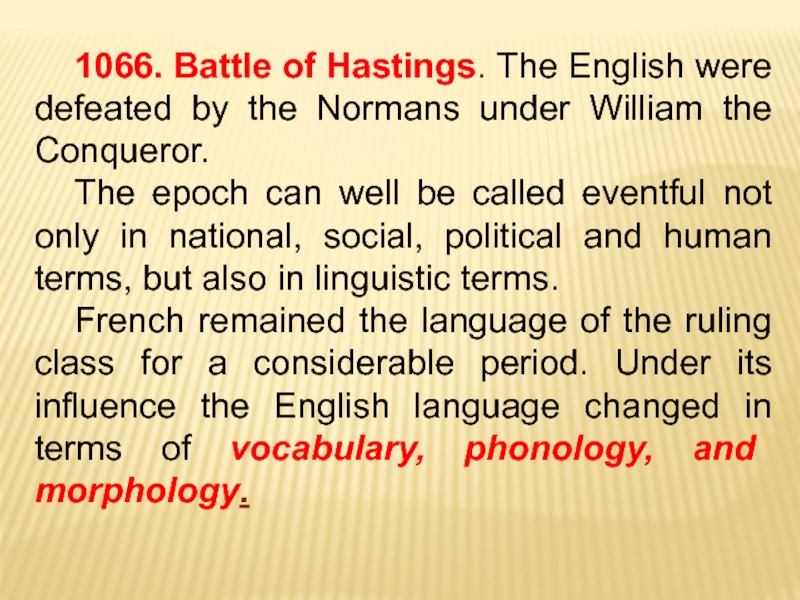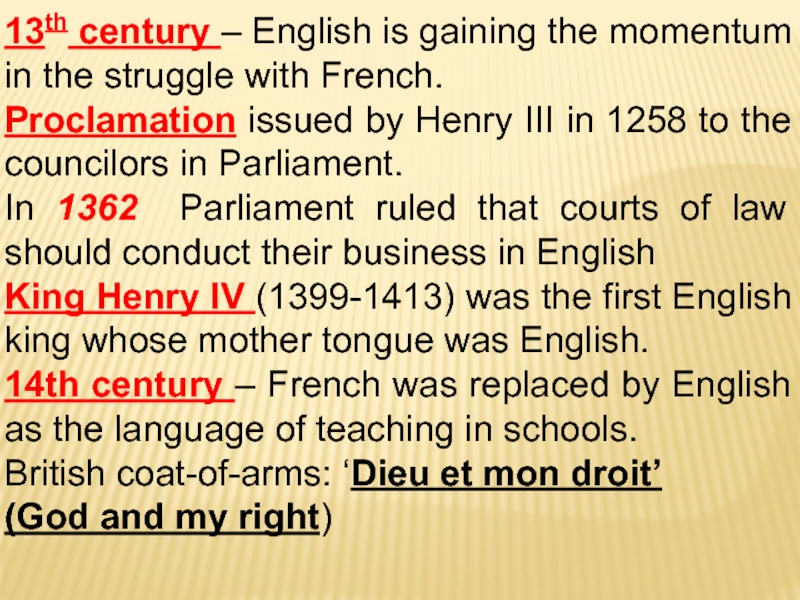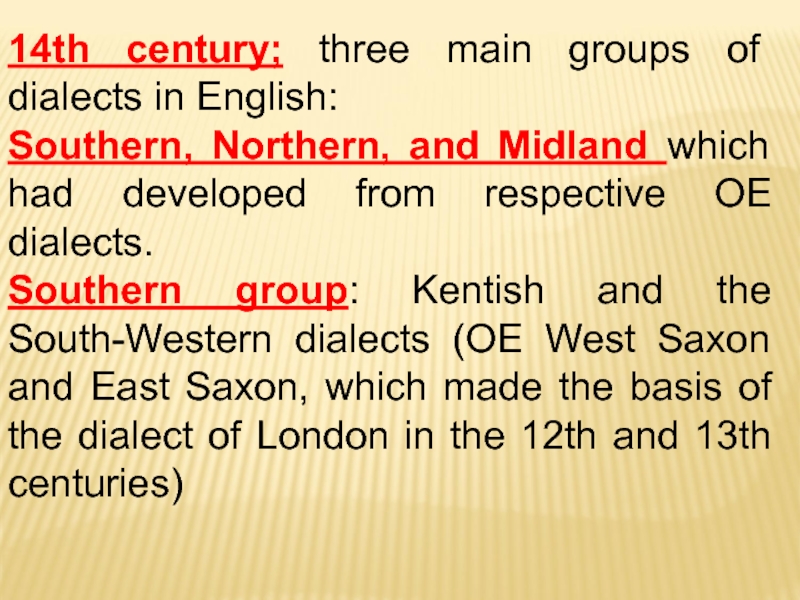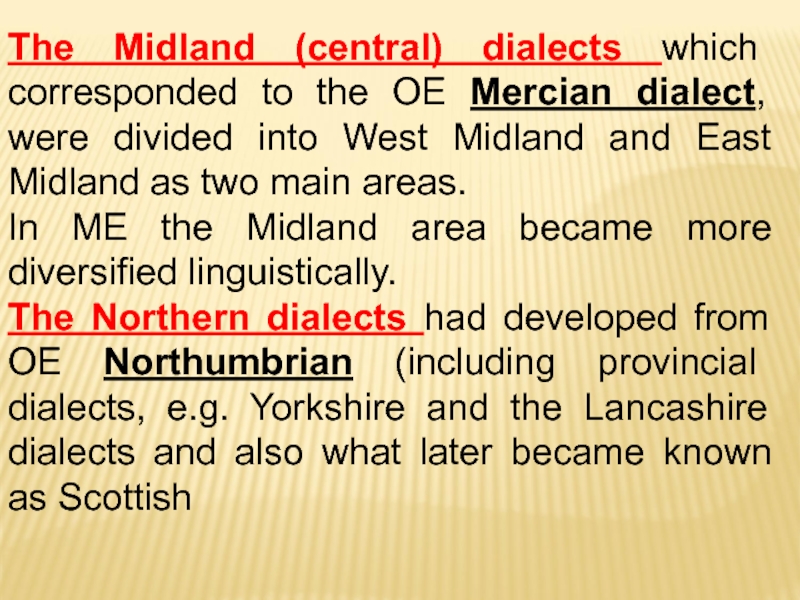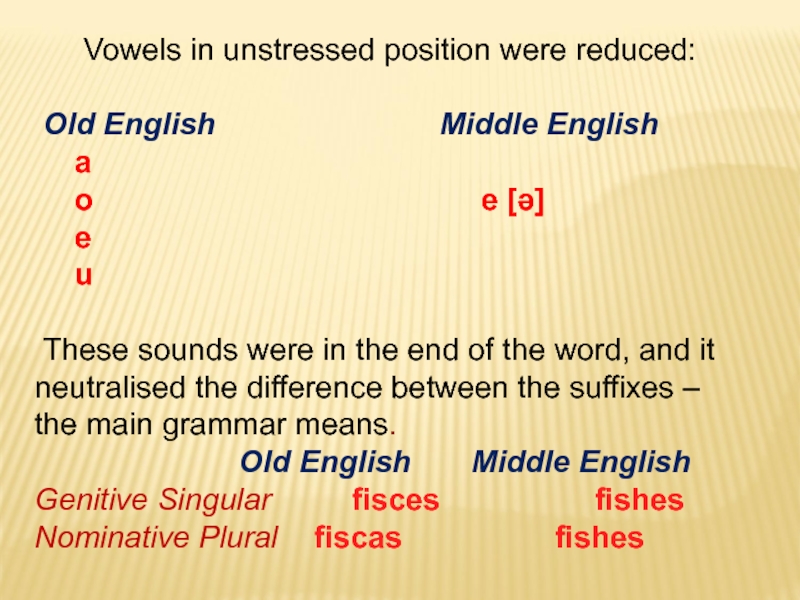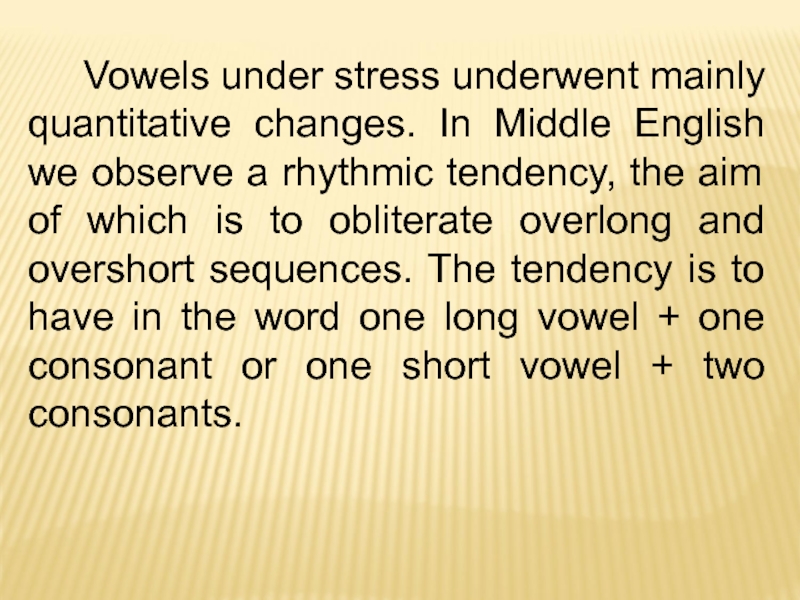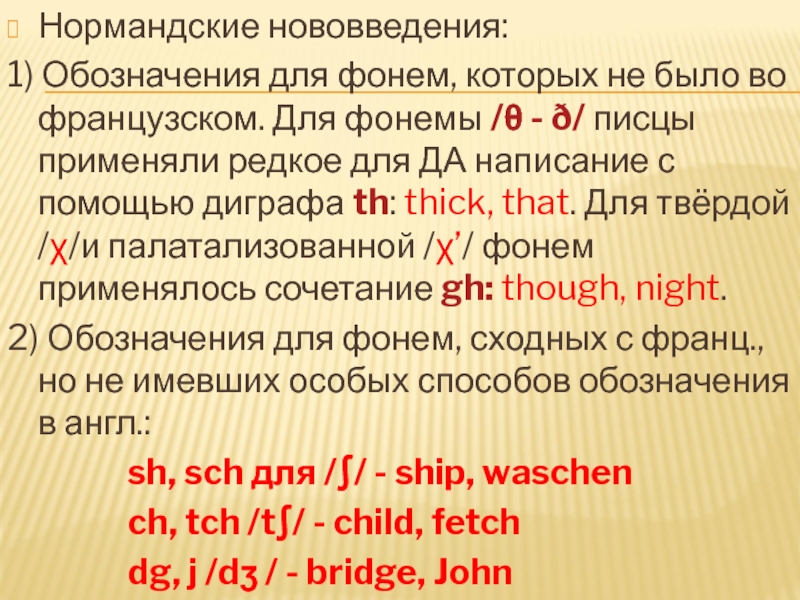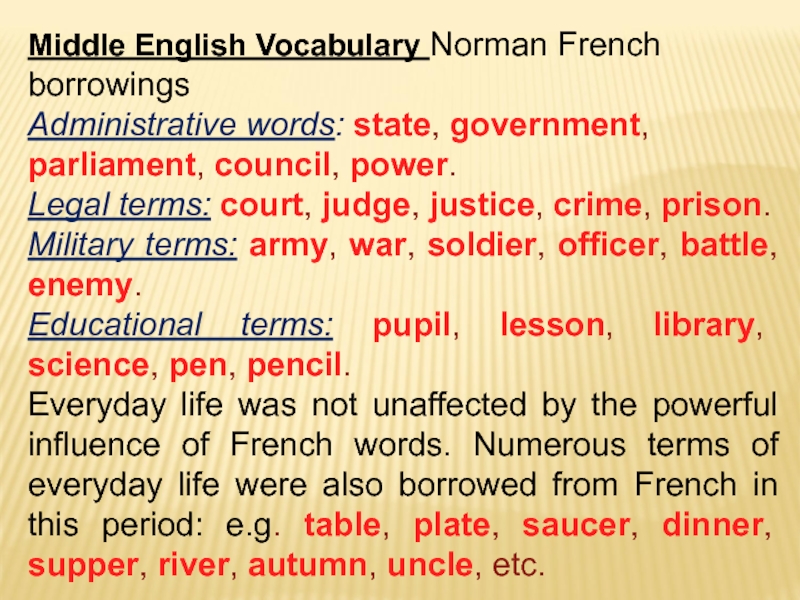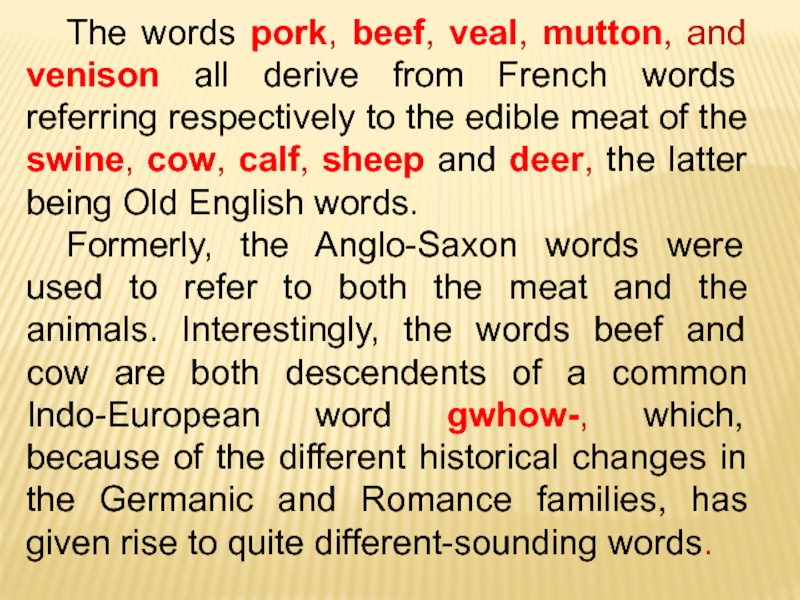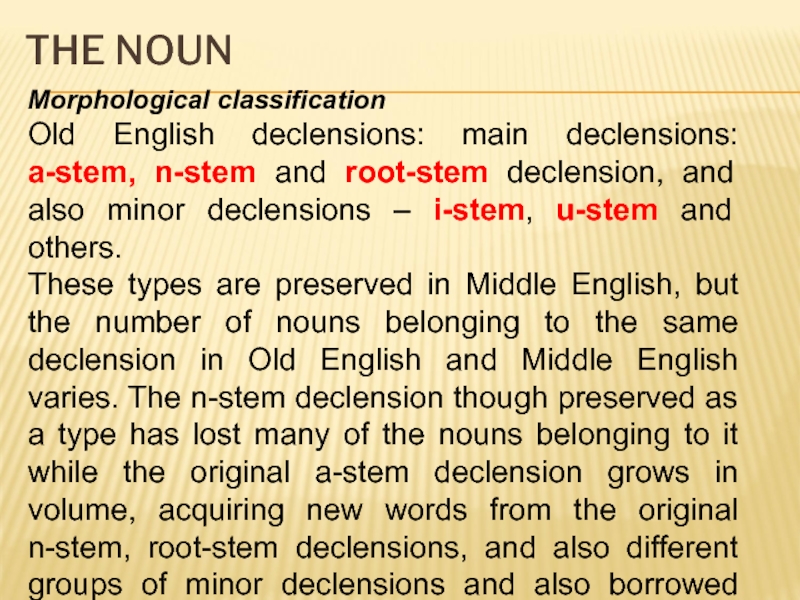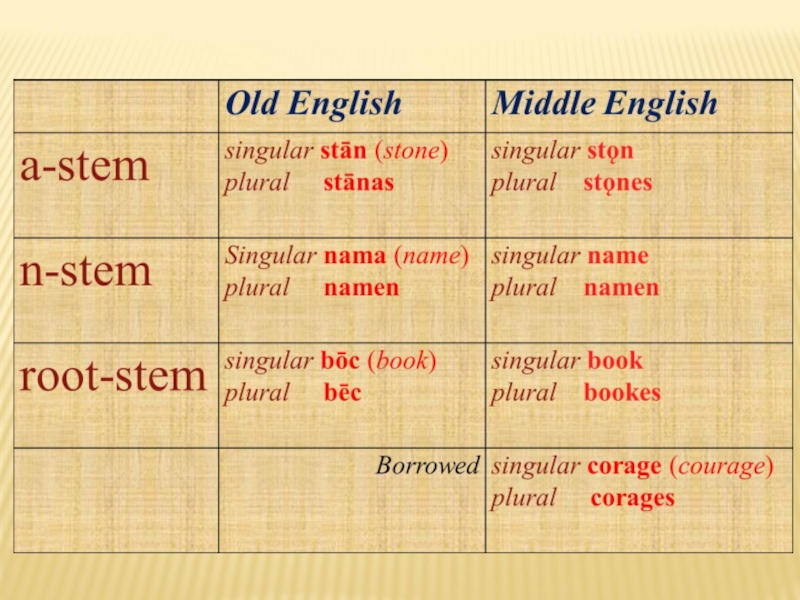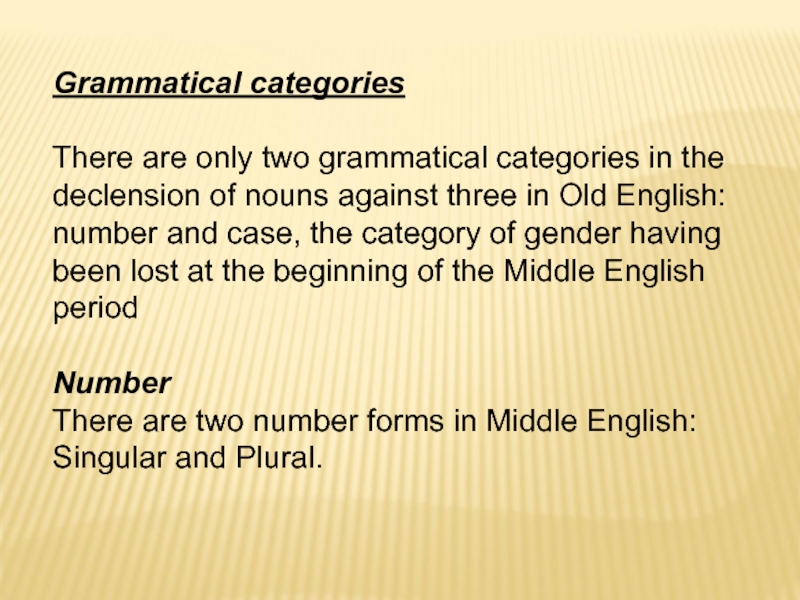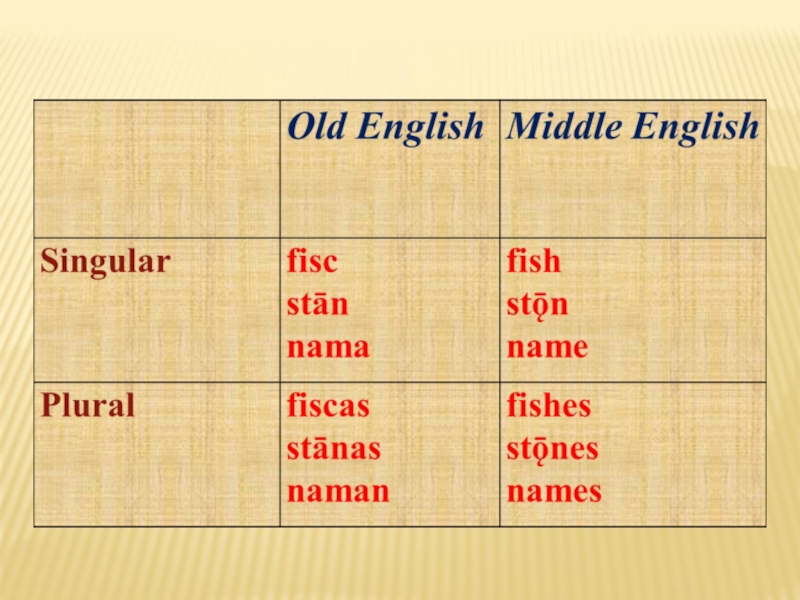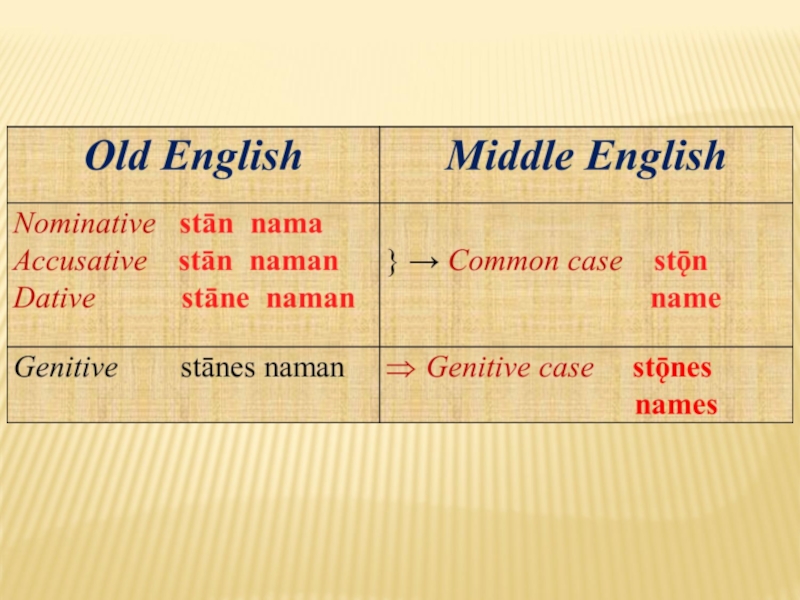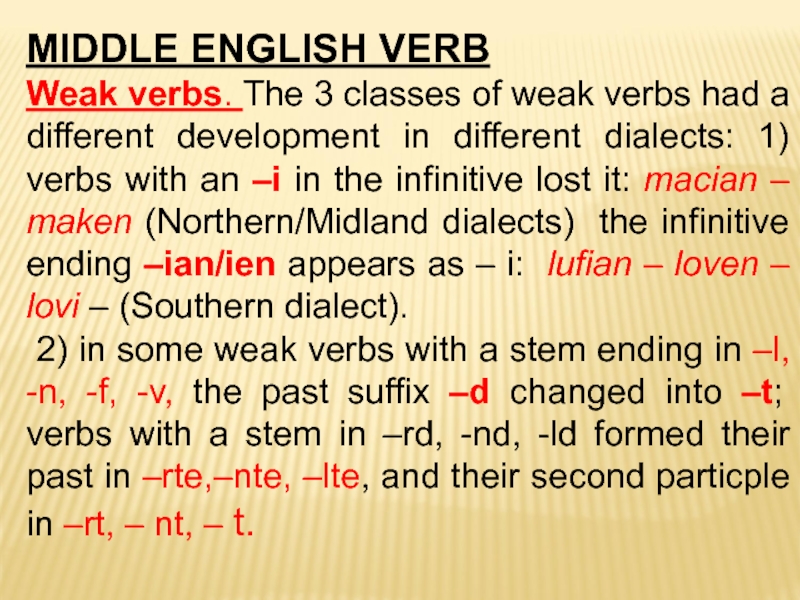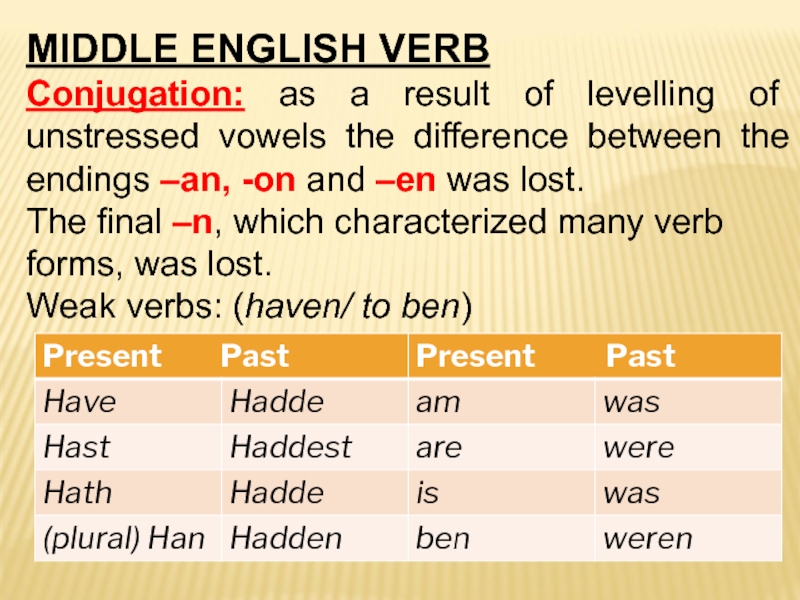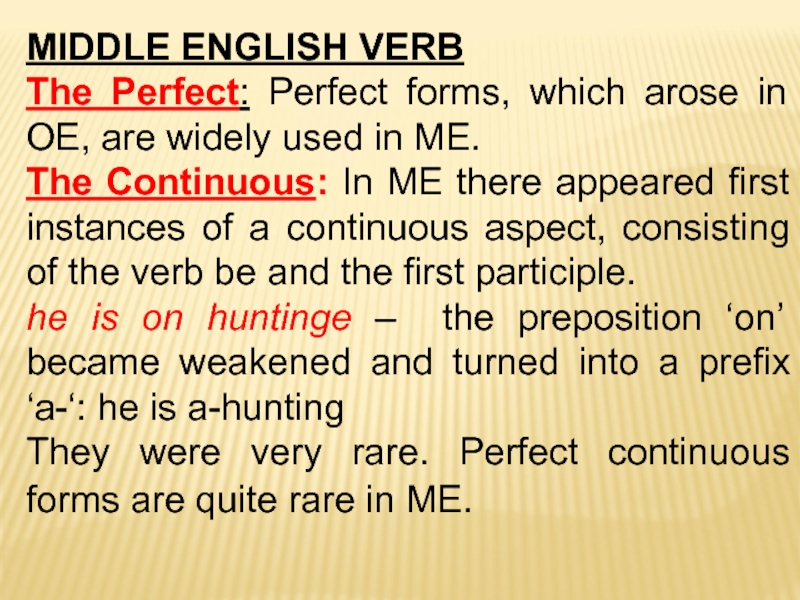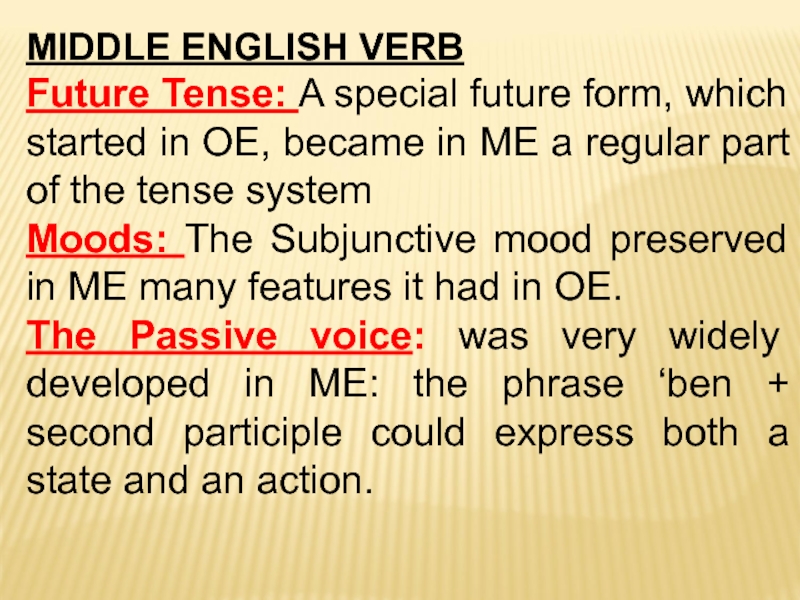- Главная
- Разное
- Дизайн
- Бизнес и предпринимательство
- Аналитика
- Образование
- Развлечения
- Красота и здоровье
- Финансы
- Государство
- Путешествия
- Спорт
- Недвижимость
- Армия
- Графика
- Культурология
- Еда и кулинария
- Лингвистика
- Английский язык
- Астрономия
- Алгебра
- Биология
- География
- Детские презентации
- Информатика
- История
- Литература
- Маркетинг
- Математика
- Медицина
- Менеджмент
- Музыка
- МХК
- Немецкий язык
- ОБЖ
- Обществознание
- Окружающий мир
- Педагогика
- Русский язык
- Технология
- Физика
- Философия
- Химия
- Шаблоны, картинки для презентаций
- Экология
- Экономика
- Юриспруденция
Middle English презентация
Содержание
- 1. Middle English
- 2. The Middle English period
- 3. 1066. Battle of Hastings. The English
- 4. 13th century – English is gaining the
- 5. 14th century; three main groups of dialects
- 6. The Midland (central) dialects which corresponded to
- 7. The Early ME dialectal division was preserved
- 8. The stress is dynamic
- 9. Vowels in unstressed position were reduced:
- 10. Vowels under stress underwent
- 11. Нормандские нововведения: 1) Обозначения для фонем, которых
- 12. 3) Обозначения для фонем, сходных с франц.
- 13. /u:/ обозначается графемой ou в словах франц.
- 14. Middle English Vocabulary Norman French borrowings Administrative
- 15. The words pork, beef, veal, mutton, and
- 16. THE NOUN Morphological classification Old English declensions:
- 18. Grammatical categories There are only two
- 20. Case The number
- 22. MIDDLE ENGLISH VERB Strong verbs: in some
- 23. MIDDLE ENGLISH VERB Weak verbs. The 3
- 24. MIDDLE ENGLISH VERB Conjugation: as a result
- 25. MIDDLE ENGLISH VERB The Perfect: Perfect forms,
- 26. MIDDLE ENGLISH VERB Future Tense: A special
Слайд 2 The Middle English period was a time of
unprecedentedly rapid development of the language. For the first 3 centuries English was only a spoken language, and as such had no form and could develop without any restrain. All the elements of the language changed fundamentally.
Слайд 3 1066. Battle of Hastings. The English were defeated by the
Normans under William the Conqueror.
The epoch can well be called eventful not only in national, social, political and human terms, but also in linguistic terms.
French remained the language of the ruling class for a considerable period. Under its influence the English language changed in terms of vocabulary, phonology, and morphology.
The epoch can well be called eventful not only in national, social, political and human terms, but also in linguistic terms.
French remained the language of the ruling class for a considerable period. Under its influence the English language changed in terms of vocabulary, phonology, and morphology.
Слайд 413th century – English is gaining the momentum in the struggle
with French.
Proclamation issued by Henry III in 1258 to the councilors in Parliament.
In 1362 Parliament ruled that courts of law should conduct their business in English
King Henry IV (1399-1413) was the first English king whose mother tongue was English.
14th century – French was replaced by English as the language of teaching in schools.
British coat-of-arms: ‘Dieu et mon droit’
(God and my right)
Proclamation issued by Henry III in 1258 to the councilors in Parliament.
In 1362 Parliament ruled that courts of law should conduct their business in English
King Henry IV (1399-1413) was the first English king whose mother tongue was English.
14th century – French was replaced by English as the language of teaching in schools.
British coat-of-arms: ‘Dieu et mon droit’
(God and my right)
Слайд 514th century; three main groups of dialects in English:
Southern, Northern,
and Midland which had developed from respective OE dialects.
Southern group: Kentish and the South-Western dialects (OE West Saxon and East Saxon, which made the basis of the dialect of London in the 12th and 13th centuries)
Southern group: Kentish and the South-Western dialects (OE West Saxon and East Saxon, which made the basis of the dialect of London in the 12th and 13th centuries)
Слайд 6The Midland (central) dialects which corresponded to the OE Mercian dialect,
were divided into West Midland and East Midland as two main areas.
In ME the Midland area became more diversified linguistically.
The Northern dialects had developed from OE Northumbrian (including provincial dialects, e.g. Yorkshire and the Lancashire dialects and also what later became known as Scottish
In ME the Midland area became more diversified linguistically.
The Northern dialects had developed from OE Northumbrian (including provincial dialects, e.g. Yorkshire and the Lancashire dialects and also what later became known as Scottish
Слайд 7The Early ME dialectal division was preserved in the succeeding centuries,
though even in Late ME the linguistic situation changed.
In Late ME, when English had been reestablished as the main language of administration and writing, one of the regional dialects, the London dialect, prevailed over the others, especially as written form of the language.
In Late ME, when English had been reestablished as the main language of administration and writing, one of the regional dialects, the London dialect, prevailed over the others, especially as written form of the language.
Слайд 8 The stress is dynamic and fixed in the
native words. But in the borrowed French words the stress was on the last syllable: licour [li'ku:r], nature [na'tu:r], etc.
New consonant sounds developed in native words:
ME [ʃ] ship [tʃ] child [dƷ] bridge
OE scio cild brycg
The resonance of the consonant does not depend so much on the position of the consonant, and voiced consonants can appear not only in intervocal, but also in initial and other positions.
New consonant sounds developed in native words:
ME [ʃ] ship [tʃ] child [dƷ] bridge
OE scio cild brycg
The resonance of the consonant does not depend so much on the position of the consonant, and voiced consonants can appear not only in intervocal, but also in initial and other positions.
MIDDLE ENGLISH PHONETICS
Слайд 9Vowels in unstressed position were reduced:
Old English
Middle English
a
o e [ә]
e
u
These sounds were in the end of the word, and it neutralised the difference between the suffixes – the main grammar means.
Old English Middle English
Genitive Singular fisces fishes
Nominative Plural fiscas fishes
a
o e [ә]
e
u
These sounds were in the end of the word, and it neutralised the difference between the suffixes – the main grammar means.
Old English Middle English
Genitive Singular fisces fishes
Nominative Plural fiscas fishes
Слайд 10 Vowels under stress underwent mainly quantitative changes. In
Middle English we observe a rhythmic tendency, the aim of which is to obliterate overlong and overshort sequences. The tendency is to have in the word one long vowel + one consonant or one short vowel + two consonants.
Слайд 11Нормандские нововведения:
1) Обозначения для фонем, которых не было во французском. Для
фонемы /θ - ð/ писцы применяли редкое для ДА написание с помощью диграфа th: thick, that. Для твёрдой /χ/и палатализованной /χ’/ фонем применялось сочетание gh: though, night.
2) Обозначения для фонем, сходных с франц., но не имевших особых способов обозначения в англ.:
sh, sch для /∫/ - ship, waschen
ch, tch /t∫/ - child, fetch
dg, j /dʒ / - bridge, John
2) Обозначения для фонем, сходных с франц., но не имевших особых способов обозначения в англ.:
sh, sch для /∫/ - ship, waschen
ch, tch /t∫/ - child, fetch
dg, j /dʒ / - bridge, John
Слайд 123) Обозначения для фонем, сходных с франц. И обозначающихся в нём
иначе, чем в англ.
Буква «с» стала обозначать звук /k/ перед гласными заднего ряда: cat, cold. Но перед гласными переднего ряда она обозначает /s/: city, cell. В англ. словах, содержащих /k/ перед гласными переднего ряда, была введена буква k: king, Kent.
Фонема /j/ стала обозначаться, как во франц., через букву y: yard, yield.
/e:/ во франц. обозначалось через ie : chief. Позднее это написание проникло в англ. слова: field, thief.
Буква «с» стала обозначать звук /k/ перед гласными заднего ряда: cat, cold. Но перед гласными переднего ряда она обозначает /s/: city, cell. В англ. словах, содержащих /k/ перед гласными переднего ряда, была введена буква k: king, Kent.
Фонема /j/ стала обозначаться, как во франц., через букву y: yard, yield.
/e:/ во франц. обозначалось через ie : chief. Позднее это написание проникло в англ. слова: field, thief.
Слайд 13/u:/ обозначается графемой ou в словах франц. происхождения: round, fountain и
в словах англ. происхождения house, loud.
/u/ было близко по звучанию к закрытому /o/ во франц.; писцы стали употреблять графему o в словах где /u/ находилось в окружении звуков, передававшихся буквами, которые содержали вертикальные штрихи: comen, love. В готическом шрифте буквы u, n, m, v сливались, поэтому написание через o вместо u способствовало лёгкости чтения.
В течение долгого времени фонемы /u/ и /v/ могли обозначаться буквами u и v без всякого различия. Эта взаимозаменяемость сохранилась до XVII в. (bvt, giue). В конце слова не могла стоять буква i; она была заменена буквой y .
/u/ было близко по звучанию к закрытому /o/ во франц.; писцы стали употреблять графему o в словах где /u/ находилось в окружении звуков, передававшихся буквами, которые содержали вертикальные штрихи: comen, love. В готическом шрифте буквы u, n, m, v сливались, поэтому написание через o вместо u способствовало лёгкости чтения.
В течение долгого времени фонемы /u/ и /v/ могли обозначаться буквами u и v без всякого различия. Эта взаимозаменяемость сохранилась до XVII в. (bvt, giue). В конце слова не могла стоять буква i; она была заменена буквой y .
Слайд 14Middle English Vocabulary Norman French borrowings
Administrative words: state, government, parliament, council,
power.
Legal terms: court, judge, justice, crime, prison.
Military terms: army, war, soldier, officer, battle, enemy.
Educational terms: pupil, lesson, library, science, pen, pencil.
Everyday life was not unaffected by the powerful influence of French words. Numerous terms of everyday life were also borrowed from French in this period: e.g. table, plate, saucer, dinner, supper, river, autumn, uncle, etc.
Legal terms: court, judge, justice, crime, prison.
Military terms: army, war, soldier, officer, battle, enemy.
Educational terms: pupil, lesson, library, science, pen, pencil.
Everyday life was not unaffected by the powerful influence of French words. Numerous terms of everyday life were also borrowed from French in this period: e.g. table, plate, saucer, dinner, supper, river, autumn, uncle, etc.
Слайд 15 The words pork, beef, veal, mutton, and venison all derive from
French words referring respectively to the edible meat of the swine, cow, calf, sheep and deer, the latter being Old English words.
Formerly, the Anglo-Saxon words were used to refer to both the meat and the animals. Interestingly, the words beef and cow are both descendents of a common Indo-European word gwhow-, which, because of the different historical changes in the Germanic and Romance families, has given rise to quite different-sounding words.
Formerly, the Anglo-Saxon words were used to refer to both the meat and the animals. Interestingly, the words beef and cow are both descendents of a common Indo-European word gwhow-, which, because of the different historical changes in the Germanic and Romance families, has given rise to quite different-sounding words.
Слайд 16THE NOUN
Morphological classification
Old English declensions: main declensions: a-stem, n-stem and root-stem
declension, and also minor declensions – i-stem, u-stem and others.
These types are preserved in Middle English, but the number of nouns belonging to the same declension in Old English and Middle English varies. The n-stem declension though preserved as a type has lost many of the nouns belonging to it while the original a-stem declension grows in volume, acquiring new words from the original n-stem, root-stem declensions, and also different groups of minor declensions and also borrowed words.
These types are preserved in Middle English, but the number of nouns belonging to the same declension in Old English and Middle English varies. The n-stem declension though preserved as a type has lost many of the nouns belonging to it while the original a-stem declension grows in volume, acquiring new words from the original n-stem, root-stem declensions, and also different groups of minor declensions and also borrowed words.
Слайд 18Grammatical categories
There are only two grammatical categories in the declension of
nouns against three in Old English: number and case, the category of gender having been lost at the beginning of the Middle English period
Number
There are two number forms in Middle English: Singular and Plural.
Number
There are two number forms in Middle English: Singular and Plural.
Слайд 20Case
The number of cases in Middle English is
reduced as compared to Old English. There are only two cases in Middle English: Common and Genitive, the Old English Nominative, Accusative and Dative cases having fused into one case – the Common case at the beginning of Middle English.
Слайд 22MIDDLE ENGLISH VERB
Strong verbs: in some classes, both the infinitive ending
–an and the past plural ending –on were weakened to –en (n): (writen wrot writen writen);
In others the past singular form began to penetrate into the past plural and the second participle to the past plural, thus preparing the reduction of the 4 main parts of a strong verb to 3
In others the past singular form began to penetrate into the past plural and the second participle to the past plural, thus preparing the reduction of the 4 main parts of a strong verb to 3
Слайд 23MIDDLE ENGLISH VERB
Weak verbs. The 3 classes of weak verbs had
a different development in different dialects: 1) verbs with an –i in the infinitive lost it: macian – maken (Northern/Midland dialects) the infinitive ending –ian/ien appears as – i: lufian – loven – lovi – (Southern dialect).
2) in some weak verbs with a stem ending in –l, -n, -f, -v, the past suffix –d changed into –t; verbs with a stem in –rd, -nd, -ld formed their past in –rte,–nte, –lte, and their second particple in –rt, – nt, – t.
2) in some weak verbs with a stem ending in –l, -n, -f, -v, the past suffix –d changed into –t; verbs with a stem in –rd, -nd, -ld formed their past in –rte,–nte, –lte, and their second particple in –rt, – nt, – t.
Слайд 24MIDDLE ENGLISH VERB
Conjugation: as a result of levelling of unstressed vowels
the difference between the endings –an, -on and –en was lost.
The final –n, which characterized many verb forms, was lost.
Weak verbs: (haven/ to ben)
The final –n, which characterized many verb forms, was lost.
Weak verbs: (haven/ to ben)
Слайд 25MIDDLE ENGLISH VERB
The Perfect: Perfect forms, which arose in OE, are
widely used in ME.
The Continuous: In ME there appeared first instances of a continuous aspect, consisting of the verb be and the first participle.
he is on huntinge – the preposition ‘on’ became weakened and turned into a prefix ‘a-‘: he is a-hunting
They were very rare. Perfect continuous forms are quite rare in ME.
The Continuous: In ME there appeared first instances of a continuous aspect, consisting of the verb be and the first participle.
he is on huntinge – the preposition ‘on’ became weakened and turned into a prefix ‘a-‘: he is a-hunting
They were very rare. Perfect continuous forms are quite rare in ME.
Слайд 26MIDDLE ENGLISH VERB
Future Tense: A special future form, which started in
OE, became in ME a regular part of the tense system
Moods: The Subjunctive mood preserved in ME many features it had in OE.
The Passive voice: was very widely developed in ME: the phrase ‘ben + second participle could express both a state and an action.
Moods: The Subjunctive mood preserved in ME many features it had in OE.
The Passive voice: was very widely developed in ME: the phrase ‘ben + second participle could express both a state and an action.
